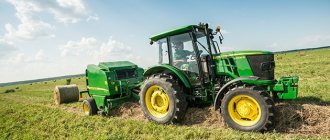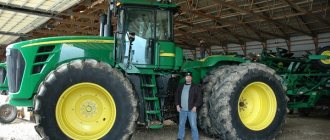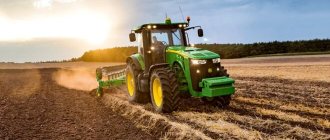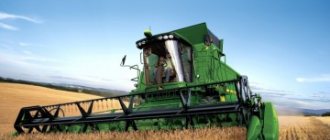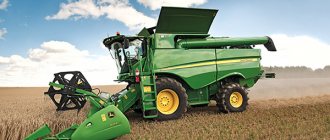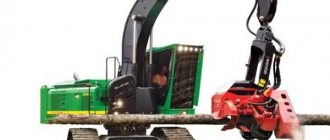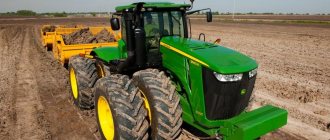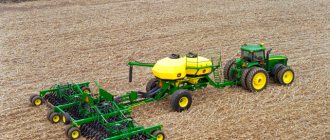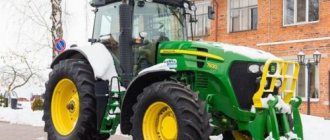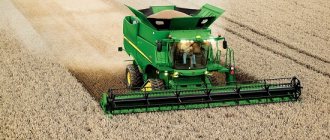Deere & Company (™:John Deere, pronounced John Deere, sometimes shortened to Deere) is a manufacturer of construction, forestry, agricultural, and commercial park and lawn care equipment with annual sales of more than $20 billion. John Deere (Deere & Company) is a global leader in the manufacture and service of advanced agricultural, forestry, construction, irrigation and landscaping equipment. The company also provides financial services and produces engines for off-road vehicles.
Birth of a brand
The history of the John Deere company began in the 19th century during the colonization of the US Midwest.
Company founder John Deere was born in 1804 in Vermont, where he worked as an apprentice in a blacksmith's shop since 1825. Young John Deere became a true master of his craft; he made excellent shovels and pitchforks.
The ensuing economic downturn forced the young man to move. He settled in Illinois. Here the work of a blacksmith was in high demand. Just 2 days after moving, John was able to open his own forge.
Constant collaboration with farmers and familiarity with their daily problems gave John Deere the idea of creating a plow that could itself clean itself of soil adhering to it. In 1837, John Deere invents a steel plow for processing sticky soils. The plow had a unique design and showed high reliability, which ensured good sales and production growth. This is how John Deere first produced custom-made agricultural machinery.
By 1848, Dir's production volume was already about 1000 similar agricultural implements per year. From the very beginning of his business, John Deere was guided by the principle: “I will never put my name on a product that does not contain the best that is in me.” John Deere continues to live by this motto today.
The company grew successfully and in 1868 it was incorporated as a corporation. John Deere's son, Charles Deere, became its vice president. He subsequently took over as president of the corporation. Charles opened branches of the company and developed a fairly large dealer network. united six companies producing agricultural machinery and equipment. This made it possible to greatly expand the range of products.
Constantly expanding its production volume and network of independent dealers, John Deere has become a manufacturer of a wide range of agricultural equipment. At the end of the 19th century, it became obvious that the transition from horse to tractor was inevitable. Since the beginning of the 20th century, many companies have been creating prototype tractors, and John Deere is developing a prototype tractor by 1914, and in 1918 the company acquires a tractor manufacturing plant. Thus, John Deere becomes a leading manufacturer of tractors and diesel engines.
In 1928, John Deere's grandson, Charles Deere Wyman, became the head of the company. He placed emphasis on John Deere, the founder of the John Deere company, development and use of the latest technologies and advanced engineering achievements in production. This approach has borne fruit. The company successfully overcame the era of the Great Depression, and by 1937 its turnover was already $100 million. During World War II, Deere & Company management continued to improve its products, which allowed it to take a strong position in the post-war market. At the end of World War II, Deere and Company became one of America's top 100 manufacturers.
In 1947, the first M model tractor was produced. Two years later, the tractor was put on caterpillar tracks and became a bulldozer. This was the beginning of the production of construction equipment. In 1955, the company was headed by William Hewitt. The period of his leadership from 1955 to 1982 became a heyday for the company. In 1956, John Deere becomes an international corporation. The company establishes its own tractor production in Mexico, buys a controlling stake in a tractor plant in Germany, which has its representative office in Spain. Over the next two years, the company entered the markets of South Africa, Argentina and France. For the convenience of its customers, in 1958 the company organized a division, John Deere Credit, through which leasing and other financial services began to be provided. During the leadership of William Hewitt, John Deere managed to take a leading position in the world in the production of agricultural, construction and forestry equipment, as well as equipment designed for the care of lawns and parks.
Robert Hanson, Mr. Hewitt's successor, worked for the company during a period of rather difficult economic conditions and intense competition. Under his influence, the corporation acquired a dynamic, flexible structure and reached a new level of sales, setting record figures in the last three years of the decade.
Hans Becherer was elected chairman of the board of directors in 1990. He continued to develop international operations. Six times during Mr. Becherer's career, the company's profits reached record levels. In August 2000 he retired. At this time, Robert W. Lane, who has extensive experience in the John Deere organization, including management of the company's agricultural division and its credit organization, became the head of the company.
Technical characteristics based on the example of the 1270 series
Launched in 1996 by the John Deer brand, the 1270 series of harvesters, produced for clear cutting, immediately gained worldwide recognition.
The technical solutions embodied in the models of this line were so successful that machines with article number 1270 still exist today, continuing to be constantly updated and improved.
Each of the modifications of the series represented a real revolutionary breakthrough in the development of technology in the category under consideration.
Harvesters of the 1270 series are divided into groups of machines of versions D and E. Forest harvesting units of this line have common features common to all versions and consist in the following parameters:
- six-wheel base;
- powerful 6-cylinder engine;
- rotating cabin;
- intelligent navigation system for controlling the sawing process and diagnosing the functioning of the main mechanisms and components.
In general, the technical characteristics of John Deere harvesters have only minor differences, and you can verify this by conducting a comparative analysis of some models of this manufacturer.
Also, such a consideration will help to delve in more detail into the root causes of the constructive perfection of the brand being described.
Version "E"
Harvesters of the 1270 E modification, launched into mass production in 2008, are machines that are significantly superior to the analogues of the previous D-series in terms of productivity, maneuverability and reliability.
Now felling large trunks and thinning old forests has become even more efficient.
Coinciding in the main structural units and elements with the previous technology, the new version of the equipment has a number of improved specifications, which can be presented in the following list:
- increase in engine power of the Tier IV standard to 170 kW;
- increase in torque , already reaching 1,125 Nm at 1,200-1,400 rpm;
- improvement of traction force indicators to parameters of 175 kNm;
- installation of a new CH7 manipulator with a 15% increased turning moment and 11% increased lift, a boom rotation angle of 220°, and a maximum extension of 8.6, 10 and 11.7 m;
- strengthening the supporting frames and, as a result, increasing the mobility of the cabin and improving the maneuverability of the entire machine as a whole.
The TimberMatic H-09 measurement and control system, which is equipped with all harvesters in the updated series, makes control even more convenient and simple.
Options for quick access to dialog boxes have been optimized, and a control function based on operating pressure indicators has appeared. The TimberLink™ program continues to distinguish these harvesters from a whole range of similar equipment.
Never before has it been so easy to monitor all operating processes occurring in equipment, detect defects and eliminate them. In addition to these options, TimberLink™ trains qualified operators to operate this equipment.
John Deere today
Today, John Deere Corporation successfully operates six large divisions:
- production of agricultural machinery and equipment
- production of construction and forestry equipment
- production of commercial equipment for parks and lawns
- lending
- engine production
- production of spare parts
Deere & Company Corporation is included in the list of 100 largest industrial companies according to Fortune magazine. John Deere products are sold in 130 countries around the world. The company is constantly expanding the scope of its presence. John Deere factories are located in Europe, Asia, North and South America. Deere & Company's annual turnover exceeds $30 billion. Every business day, the corporation invests more than $1.5 million in research and development. Among companies operating in the same fields as John Deere, the American manufacturer has one of the highest ratios of funds invested in science to sales.
John Deere in Russia
John Deere has long-standing trade relations with Russia.
The first deliveries of plows began in 1880. After the Russian revolution, cooperation resumed in 1923. Tractors began to be imported into Soviet Russia. In the 70s, the list of equipment supplied to the USSR also included logging equipment. In 1977, the first forwarder was delivered, produced under the Lokomo brand. The mid-80s were marked by the opening of the first service center in the USSR. This was facilitated by the delivery of a large batch of Timberjacks to the Far East. This center still operates today under the name OJSC Daltimbermash. The demand for John Deere equipment is constantly growing. This gave impetus to the development of a network of dealer and service centers. Until 2005 Consumers of John Deere forestry equipment knew them under the Timberjack brand. Since 2009 John Deere road construction equipment also began to be supplied to Russia. In 2010 The opening of a production center and a Euro-Asian distribution center for John Deere spare parts took place in Domodedovo, Moscow Region.
John Deere forestry equipment: maneuverability and service
The timber market of the Krasnoyarsk Territory has revived. Demand creates supply - dealers are expanding their line of forestry equipment with new models and strengthening the service component.
The magazine “LPK Siberia” talked about the results of 2017 and work plans for the current year with the sales manager of logging equipment in the Krasnoyarsk Territory and the Republic of Khakassia (dealer of John Deere logging equipment) Danil Terpugov.
Danil, what was 2022 like for the forestry equipment market in the Krasnoyarsk Territory?
Judging by the work of our company, the year was positive and productive. The demand for equipment has increased – it has increased two to three times compared to 2016. Loggers, usually small and medium-sized companies, came and inquired about the machines and the terms of purchase. One of the reasons for the positive dynamics, in my opinion, is the increased demand for round timber from China. To answer this demand, loggers are looking for opportunities to work more and more efficiently, hence the increase in equipment sales. In a word, we are pleased with last year’s results – it was a solid 4. Why not 5? Because there is always something to strive for - competition in the forestry equipment segment in the region is strong.
Are John Deere logging equipment well known in the Krasnoyarsk Territory? Why do loggers choose it?
Yes, the John Deere brand is well known in the region. Loggers value it for its reliability, ease of operation and maintenance. John Deere continuously improves its technology and invests heavily in research and development to ensure environmentally friendly logging.
What models of John Deere forestry equipment are in greatest demand in the region?
Our company offers two types of harvesting machines – log and cut-to-length. There is a noticeable increase in demand for cut-to-length machines. Cut-to-length machines, harvesters and forwarders are effective in final fellings, in conditions of low concentration and scattered logging stock, and in direct timber removal. Wheeled maneuverable equipment can move from plot to plot under its own power, easily covering 15–20 km. This is exactly the type of equipment chosen by small and medium-sized loggers working on logging sites with a logging volume of 60–70 thousand cubic meters.
If we talk about specific models, the most popular harvester models are the six-wheeled John Deere 1270G, eight-wheeled John Deere 1270G 8W and the flagship of the harvester line - the powerful John Deere 1470G; forwarders – John Deere 1510G and John Deere 1910E.
Has the company introduced new models of forestry equipment to the market?
The eight-wheel harvester 1270G 8W is a relatively new model that has found its buyer in the Krasnoyarsk Territory. The machine is designed to work on very rough terrain and marshy soils. The rear axle with tandem bogies provides maximum stability, which, together with improved geometric cross-country ability, allows you to confidently work on slopes. The machine exerts low pressure on the ground, which is especially important when moving on soft soils. The 1270E 8W harvester has a higher tractive force of 210 kN compared to its six-wheeled brother, as well as a more powerful engine.
Since 2016, John Deere has launched a new series - G, these are updated E-series models that take into account the wishes of equipment users. In particular, G-series machines cope well with their tasks in the low temperatures of the Siberian region.
Construction of forest roads is an important task for any logger. What solutions does John Deere offer?
The economical and relatively lightweight (about 20 tons) bulldozer 850J-II is a new, but already well-proven model. The machine, weighing 18–20 tons, is ideal for developing forest roads: the bulldozer is characterized by high productivity and maneuverability. Fuel consumption is reduced by almost a quarter compared to previous models. Good service accessibility - easy access to dipsticks, filler necks, batteries, radiators and vertically mounted filters simplifies daily maintenance of the machine.
Is your company developing a trade-in program for forestry equipment?
Yes, there is such a program. Unlike Europe, where loggers use trade-in to renew their fleet of equipment every 4–5 years, in Russia this trend is only gaining momentum. However, already now about 10–15% of the sales volume of new equipment is accounted for by trade-in - as a rule, we take the equipment to pay the initial lease payment. After repair, used equipment finds new owners in the form of small companies who cannot yet purchase new machines, but want to harvest timber using high-quality equipment.
What financial schemes are most often used when selling new and used equipment?
85–90% of transactions are leasing, which is understandable. This is the best option compared to a loan or extracting funds from the “turnover”. Plus, loggers can save on VAT refunds.
Often the decisive factor when choosing equipment is subsequent service and repair. What options does the John Deere forestry equipment service include? At the user’s request, a so-called service contract is concluded between him and the dealer, according to which the logger can count on certain maintenance options. Service is a priority for our company, so we constantly maintain the required volume of spare parts in stock and expand the staff of service engineers.
Over the past year, it has increased by four people - now 10 engineers service John Deere equipment in the region. A division of the company operates in Boguchany - it has a spare parts warehouse and three engineers. This is convenient for customers: there is no need to travel to Krasnoyarsk for this or that spare part. Our immediate plans are to further strengthen the service component: we expect to open a similar unit in another city in the region.
Magazine "LPK Siberia" No. 1 / 2018
John Deere History Milestones
1837 John Deere invents the first cost-effective self-cleaning steel plow.
1848 John Deere moves company headquarters from Grand Detour to Moline, Illinois.
1868 A concern is created, bearing the name Deere and Campaigns.
1918 The acquisition of the Waterloo Gasoline Engine Company (owned by Waterloo Boy Tractors) marks the beginning of John Deere's tractor manufacturing activities.
1956 Having purchased a partnership in Germany and a partnership in Mexico, John Deere lays the first stone on the path to gaining the status of an international corporation.
1958 John Deere Credit Company begins its domestic financing business for John Deere equipment.
1963 John Deere expands its product range by adding lawn care and tillage machines to its portfolio.
1966 John Deere sales exceed $1 billion for the first time.
1973 Farms prosper and demand for agricultural machinery increases. Total sales of John Deere products reach $2 billion for the first time.
1979 The number of people employed in the company reaches a record for all this time - 65,392. Sales reach 5 billion, revenues amount to $310 million - both amounts are record amounts.
1998 The company's net income reaches $1 billion.
2000 Robert W. Lane becomes the head of the company. John Deere acquires the world's leading manufacturer of forestry equipment.
John Deere forestry equipment
John Deere is a world-famous brand company specializing in the manufacture of highly specialized equipment for construction, agriculture, forestry and other manufacturing sectors of the economy. It was founded in 1837 in the USA and at first was a workshop, which over time turned into a huge engineering production that conquered the world market thanks to the efficiency and reliability of its products.
The superior quality of John Deere logging equipment ensures trouble-free operation and high productivity for many years.
The range of forestry equipment includes harvesters, forwarders, feller bunchers, and skidders.
Harvesters and forwarders play the main role in timber harvesting. Both vehicles are functionally connected, and in inaccessible areas of the forest such self-propelled equipment is simply irreplaceable.
John Deere harvesters
John Deere harvesters have a wide operating range: felling, bundling, delimbing, etc.
Advantages (Quality Priorities)
- Forestry harvesters are of high quality and have a number of advantages:
- low fuel consumption;
- maximum maneuverability;
- guarantee of work safety in any conditions
- soil instability;
- powerful motor characteristics;
- built-in on-board computer with automatic configuration and diagnostics of functions performed;
- special chassis that maintain the stability of the wheeled version of the harvester on uneven terrain.
Innovation
Recent developments in machine production have made the settings of the main parameters automatic and corresponding to the required result in terms of diameter, width, etc. For this purpose, the pressure of the knife is adjusted equally.
The amount of work completed is also automatically calculated, and, if desired, the required indicators are printed. If there is a shortage of free space, you can use a manipulator equipped with telescopic arms.
The John Deere range of forestry equipment includes wheeled and tracked machines, as well as harvesters with a rotary platform.
Wheeled
Harvesters on wheels are made of the strongest steel and are designed for many years of use. They are equipped with a diesel engine and are equipped with a fixed or rotating cabin and are designed for thinning clearings and frontal cutting of forests.
Tracked
Automated tracked vehicles are very fuel efficient, stable on uneven surfaces and have high power. This type of equipment is well suited for working on rough terrain. The hydraulic design allows easy access to the main components of the harvester.
With movable platform
Harvesters on tracks and with a turntable are equipped with a special self-cleaning and cooling system, due to which fuel consumption is reduced and service life is increased many times over. The machine is designed for the most severe operating conditions.
John Deere forwarders
Forwarders are equipped with an efficient manipulator design, hydraulic transmission and, accordingly, powerful traction, therefore they are ideal for uneven ground surfaces with a large number of slopes and ravines.
The equipment is used for sorting and collecting timber with subsequent loading and transportation to the warehouse. In addition, some forwarder models are equipped for thinning forest strips.
The forwarder has dual automatic control and a swivel operator's seat, which allows you to work without damaging the ground surface.
The first forwarders were released twenty years ago and immediately became universally recognized models in their industry. In terms of configuration, all machines are equally equipped, but differ in power.
Small forwarders have the smallest lifting capacity of 9-11 tons, medium-sized machines lift a weight of 12-13 tons. The most powerful is large equipment, capable of transporting loads weighing up to 19 tons.
Main structures
The base of the forwarder is the front and rear half-frame, connected to each other by strong joints. In the front part there is an engine and a movable driver's cabin, controlled automatically and protected by a metal grille from the cargo area located on the rear half-frame. The manipulator is located between the operator's cabin and the transport platform.
The chassis of a self-propelled vehicle consists of 6 or 8 drive wheels, adapted for movement in difficult terrain; sometimes the rear wheels of the platform are replaced with tracks, which increases traction.
The mechanical-hydrostatic transmission allows you to reach speeds of up to 23 km/h. The E series forwarders, released in 2010, are equipped with an innovative control system, have an updated option for simultaneous rotation of the cabin and manipulator, and are equipped with an automatic leveling function.
Today, medium John Deere forwarders can be purchased at prices ranging from 13 to 17 million rubles. The cost may vary depending on the year of manufacture, the general condition of the machine and the amount of time worked. Used equipment costs several times less - about 5-7 million rubles.
Small equipment
Forwarder “810E” is the smallest model in the class of small machines. Engine – 4.5 liters, power – 134 hp. This “baby” can transport a load weighing 9 tons. The chassis has 8 wheels and the ability to replace them with rubber tracks. The machine has good maneuverability and can be used in narrow, hard-to-reach parts of the forest.
Sample “1010E” is one of the best models in this class. Its carrying capacity is 11 tons. The machine has two modifications: six-wheeled and eight-wheeled, the function of increasing the transport platform and a bulldozer blade has been added. Both small class models are equipped with halogen lighting, including on the manipulator. The forwarder “1010E” produced in 2011 costs about 8-9 million rubles.
Medium technique
Model “1110E” has a load capacity of 12 tons, the engine power of this unit is 183 hp. The machine is used for thinning old and young trees, frontal and selective cutting. The eight-wheel chassis allows the vehicle to overcome difficult ground surfaces at a fairly high speed.
The forwarder model “1210E” transports timber weighing 13 tons, the engine power is 188 hp. The model’s controls are conveniently built into the armrests of the driver’s seat; the model is also equipped with rear-view cameras and the function of full cab rotation together with the rotation of the manipulator, which has a positive effect on the speed of loading assortments. Safety during operation is ensured by weight sensors specially equipped on the boom.
The new model “1110E” can be purchased at a price of 13.6 million rubles, the car “1210E” for 17 million rubles.
Big machinery
Large class units have large dimensions, which does not prevent them from maintaining high speed and maneuverability. This is possible due to increased power and intelligent control of the mechanism. Such forwarders are used for forest restoration work and thinning of old trees.
The 1510E machine has a load capacity of 15 tons and has a diesel engine with a power of 195 hp.
Model “1910E” is the most powerful of all forwarders, transports a load of logs weighing 19 tons, engine power is 249 hp.
Both models are capable of transporting huge loads in difficult and difficult terrain. These mechanisms help to carry out logging operations with high productivity.
The “1510E” model, taking into account the hours worked, can cost from 6-7 million rubles, the “1910E” forwarder with mileage can cost 13-14 million rubles.
Skidders are designed to transport large and heavy loads of timber in rough terrain and are capable of performing several operations to pick up logs simultaneously. Centralized hydraulics gives this opportunity to the technology.
In mountainous areas, more compact and mobile equipment is required, and choker skidders and tractors controlled by one lever, but faster with sufficiently high power, are more suitable here.
Among John Deere products there are skidders with a significant fixed grip, which cannot be affected even by very strong vibration.
Forestry equipment helps to carry out large-scale work with minimal fuel and operating personnel costs. Thanks to its durability, versatility and reliable quality, John Deere equipment has long been a leader in highly specialized mechanical engineering not only in the Russian market, but throughout the world.
John Deere equipment for construction and other purposes
- crawler and quarry bulldozers
- lawn mowers
- loaders (fork loaders, crawler loaders, front loaders, quarry loaders, telescopic loaders)
- graders
- mini loaders
- scrapers
- crawler and wheeled tractors
- mini tractors
- forwarders
- pipelayers
- harvesters
- grab, quarry, wheeled and crawler excavators
- mini excavators
- backhoe loaders
Company website:
Alternative names:
Deere |
Deere & Company | John Deere | John Deere | Deere offers a wide range of spare parts for the entire range of John Deere special equipment.
